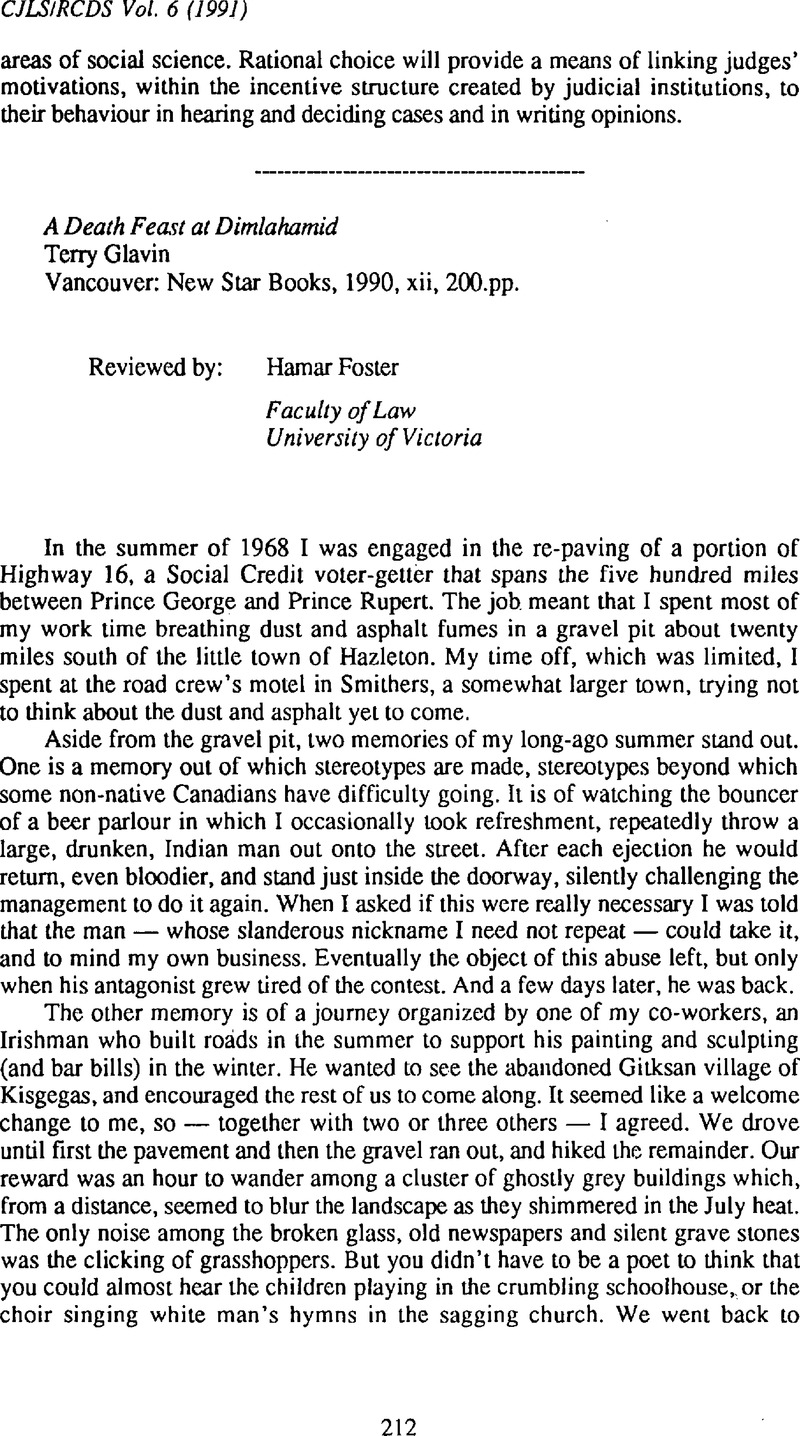No CrossRef data available.
Published online by Cambridge University Press: 18 July 2014

1 “Closing Statement of the Chiefs” (Gisdaywa, Delgam Uukw, Yagalahl, and Maas Gaak) in Delgam Uukw el al. v. The Queen,
2 All further references to page numbers in text of review will be to Glavin's book, unless otherwise indicated.
3 Chapter Seven, “When Goats Feasted Men.”
4 Barbeau, Marius, The Downfall of Temlaham (Edmonton: Macmillan 1928Google Scholar; new edition published by Hurtig Publishers, 1973). For a recent discussion of the military side of the 1888 “rebellion,” see: Campbell, Ken, “The Skeena War,” The Beaver, 69, 4 (1989), 34Google Scholar.
5 This was a common means of dealing with sorcerors or persons whose insanity threatened the group in aboriginal law. For another Canadian example see Fiddler, Chief Thomas and Stevens, James R., Killing The Shaman (Moonbeam, Penumbra Press 1985)Google Scholar.
6 There really was no rebellion on the Skeena so the troops were not used; but the recent events at Oka suggest that this is not an exclusively nineteenth century response.
7 Brody, Hugh, Maps and Dreams: Indians and the British Columbia Frontier (Vancouver: Douglas & McIntyre, 1981)Google Scholar.
8 On the Dunne-za, see also Riddington, RobinTrail to Heaven: Knowledge and Narrative in a Northern Native Community (Vancouver: Douglas & McIntyre, 1989)Google Scholar, and Little Bit Know Something: Stories in a Language of Anthropology (Vancouver: Douglas & McIntyre, 1990)Google Scholar.
9 For example, readers interested in a fuller, less one-dimensional account of the potlatch law should consult Cole, Douglas and Chaikin, Ira, An Iron Hand on the People: The Law Against the Potlatch on the Northwest Coast (Vancouver: Douglas & McIntyre, 1990)Google Scholar.
10 Wiigyet et al. v. District Manager Kispiox Forest District et al. BCSC, 20 November 1990, Smithers Registry No. 5728. I am grateful to Mr. C.F. Willms, counsel for the District Manager, for bringing this case to my attention. The BC Court of Appeal had previously enjoined Westar from building roads into the Shedin watershed in 1989, but had allowed them to put in the footings for a proposed bridge across the Babine River in case the Gitksan lost their land claim case: Westar Timber Ltd. v. Giksan- Wet‘suwet’en Tribal Council 1989, 37 BCLR (2d) 352 (BCSC).
11 Wiigyet et al. v. District Manaqer, above n.11 at 14.
12 And, as I noted earlier, at least one of the original plaintiffs, Delgamuukw, died, and his name was passed on to a second, then a third, successor in title: see text accompanying no 1, above.
13 See, for example, pp. 77–78, which is an account of how stressful Tenimgyet (Art Matthews, a sawfiler at the Gitwangak sawmill) found testifying to be. For eight days he had to explain details of the ada'ox (history) for which his hereditary name made him responsible. When it was over, he “wanted to ceremonially close the symbolic bent-cedar box that contained his ada'ox as soon as possible, get out of Vancouver and get back home.” Chief Justice McEachern's handling of the distinction he drew between the ada'ox and antimahlasxw (anecdotal evidence) may be found in Uukw (Tait) et al. v. Reqina in right of British Columbia and Attorney General of Canada 1987, 15 BCLR (2d) 326 (BCSC).
14 See generally, Harmon, Sasha, “How Litigation Distorts History,” in the proceedings of The Fourth Annual Western Reqional Indian Law Symposium, University of Washington School of Law (1990) pp. 262–281Google Scholar.
15 Delgam Uukw v. B.C. (1989), 38 BCLR (2d) 165, p.166.
16 The qualification re hunting and fishing is necessary because this more narrowly defined title was recognized in Hamlet of Baker Lake et al. v. Minister of Indian Affairs and Northern Development et al., 1980 107 DLR (3d) 513 (FCTD), where the plaintiffs were Inuit.